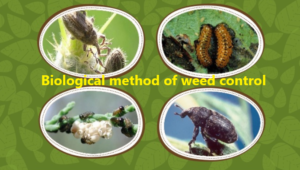 |
| Biological method of weed control with Merits and Demerits. |
Biological method of weed control:
The primary objectives in biological control of weed to uneconomic levels of deduction of infestation. So biological method is divided into two broad groups involving cropping and competition and parasites, predators and pathogens.
Cropping and Competition:
This method involves biological activities like growth and vigor, it is considered appropriate to treat it as one of the biological methods. The various practices in cropping and competition methods are as under.
Crop competition:
Vigour and competitive ability are some of the important criteria man uses fr selecting and developing improved crop varieties. These competitive crops, also known as smother crops are very valuable in any weed control program. They complete better with weeds for plant nutrient, soil moisture, sunlight and carbon di – oxide. The principle competitive crops include corn, sorghum, soybeans, cowpea etc.
This method, however can be used in conjunction with the other weed control methods.
Crop rotation:
Proper rotation and sequence of crops result in reduced weed growth. Continuous growing of one crop could result in an increase in the population of weed that characteristically associated with it.
Plant population:
Closer planting giving higher plant population have a competitive advantages over weeds. Plant population can be increased by reducing the row spacing or plant to plant spacing within the row. This method could be useful in crops where row spacing is too wide to allow prolific weed growth.
Parasites, predators and pathogens:
In this method of biological weed control, the natural enemies of the plants like insect and disease organisms are employed.
Kinds of enemies:
Of the wide range of the organisms, biological control of weeds, insects have received attention and may still do so. Insect that were found effective belong to Lepidoptera, Hemiptera, Coleoptera, Diptera, Hymenoptera etc. In some situation, mites have also proved effective.
Biological control also employs a wide variety of microbial pathogens and parasitic higher plants. These includes obligate parasites like viruses, fungi that developed only on live plants. Preferential parasites which includes many fungi and bacteria and saprophytes like some bacteria and fungi that usually develop on dead organisms but are capable of attacking live plant.
Merits
1) Herbicide can be recommended for adverse soil and climatic conditions, as manual weeding is highly impossible during monsoon season.
2) Herbicide can control weeds even before they emerge from the soil so that crops can germinate and grow in completely weed-free environment at early stages. It is usually not possible with physical weed comfort.
3) Weeds, which resemble like crop in vegetative phase may escape in manual weeding. However, these weeds are controlled by herbicides.
4) Herbicide is highly suitable for broadcasted and closely spaced crops.
5) Controls the weeds without any injury to the root system of the associated standing crop especially in plantationcrops like Tea and Coffee.
6) Reduces the need for pre planting tillage.
7) Controls many perennial weed species.
8) Herbicides control the weed in the field itself or insitu controlling where as mechanical method may lead to dispersal of weed species through seed.
9) It is profitable where labour is scarce and expensive.
10) Suited for minimum tillage concept.
11) Highly economical.
Demerits
1) Pollutes the environment
2) Affects the soil microbes if the dose exceeds
3) Herbicide causes drift effect to the adjoining field
4) It requires certain amount of minimum technical knowledge for calibration
5) Leaves residual effects
6) Some herbicide is highly costlier
7) Suitable herbicides are not available for mixed and inter-cropping system.
Pathogens spread by a variety of means, including wind, splashing rain, insects and animals, contact of host parts, direc vegetative growth, explosive seed discharges.
i. Insect: In Lantana camera was controlled by beetle.
ii. Fungi: Aeschynomeno verginaca can be controlled by Colletotricum gloeosporioides
iii. Mites: Spider mites is found to be useful in controlling pickly pear.
iv. Fish: Common carp and chineses carp control aquatic weeds.
v. Animal: Cattle, goat, sheep etc. Feed on different weed selectively.
Useful Agricultural Websites
